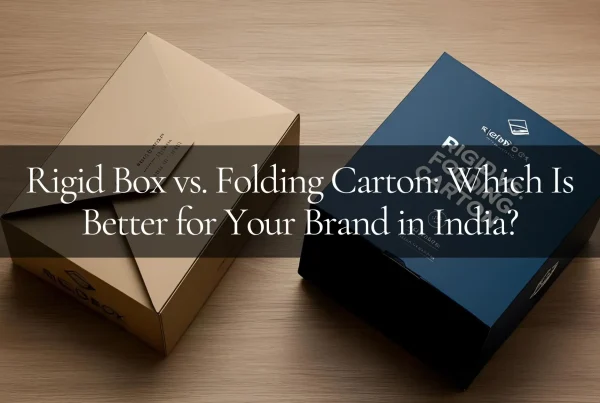When it comes to packaging your products, choosing the right material for your packaging boxes is crucial. The packaging material not only protects your products during transit but also plays a significant role in enhancing your brand image. This comprehensive guide will help you understand the importance of selecting the right packaging material, the different types available, and factors to consider when making your decision. We will also explore popular packaging materials and their properties, as well as customization options to make your packaging stand out.
Understanding Packaging Materials
The packaging material used for your boxes is more than just a means of enclosing your products. It serves as the first point of contact with your customers and can significantly influence their perception of your brand. The right packaging material should not only protect your products from damage but also reflect the value and quality of what’s inside.
When it comes to choosing the right packaging material, there are several factors to consider. Firstly, it ensures your products reach your customers in perfect condition, reducing the risk of damage during transit. Imagine the disappointment of receiving a package with a damaged product inside. By selecting the appropriate packaging material, you can minimize this risk and ensure customer satisfaction.
Secondly, the choice of packaging material plays a crucial role in creating a positive first impression of your brand. When customers receive a well-packaged product, it conveys a sense of professionalism and attention to detail. On the other hand, if the packaging appears flimsy or poorly designed, it may give the impression that the product inside is of low quality. Therefore, it is essential to choose a packaging material that aligns with your brand image and reinforces its quality.
The Importance of Choosing the Right Packaging Material
Finally, selecting the right packaging material can also have environmental benefits. In today’s world, where sustainability is a growing concern, it is crucial to consider the environmental impact of packaging materials. Some materials, such as cardboard and glass, are more eco-friendly as they are recyclable, biodegradable, and can be easily reused. By opting for these materials, you can contribute to reducing waste and promoting a greener future.
However, it is important to note that not all packaging materials are created equal in terms of their environmental impact. Plastic packaging materials, for instance, have raised concerns due to their non-biodegradable nature. While plastic offers certain advantages such as durability and flexibility, it is essential to explore alternative options that are more sustainable and eco-friendly.
Different Types of Packaging Materials
There is a wide range of packaging materials available, each with its own unique properties and advantages. Cardboard, for example, is a popular choice due to its versatility, affordability, and recyclability. It can be easily customized to fit various product shapes and sizes, making it an excellent option for businesses with diverse product lines.
Corrugated boxes, on the other hand, provide enhanced protection through their layered construction. The corrugated design adds strength and cushioning, making them ideal for shipping fragile or delicate items. Additionally, they are also recyclable and can be reused multiple times, making them a sustainable choice.
Plastic packaging materials, such as polyethylene and polypropylene, offer benefits such as water resistance and durability. They are commonly used for products that require moisture protection or have specific handling requirements. However, it is important to consider the environmental impact of plastic and explore alternatives whenever possible.
Glass packaging materials are known for their premium look and feel, making them a popular choice for high-end products. They are not only recyclable but also offer excellent product visibility, allowing customers to see the contents of the package. Glass is a sustainable option that can be recycled indefinitely without losing its quality.
By understanding the characteristics of these packaging materials, you can make an informed decision based on your specific product requirements. Whether you prioritize protection, sustainability, or aesthetics, there is a packaging material that can meet your needs and enhance your brand’s image.
Environmental Impact of Packaging Materials
As consumers become more environmentally conscious, the impact of packaging materials on the environment is a significant consideration. Opting for eco-friendly packaging materials not only reduces waste but also demonstrates your commitment to sustainability.
Cardboard, for example, is made from renewable resources and can be recycled multiple times. It is biodegradable, meaning it will break down naturally over time, minimizing its impact on landfills. By choosing cardboard packaging, you can contribute to a circular economy and reduce your carbon footprint.
Glass packaging is another sustainable option. It is made from abundant natural resources such as sand and can be recycled endlessly without losing its quality. By using glass packaging, you can help conserve resources and reduce energy consumption associated with manufacturing new glass products.
On the other hand, plastic packaging materials have raised concerns due to their non-biodegradable nature. Plastic waste can take hundreds of years to decompose, polluting the environment and harming wildlife in the process. It is important to explore alternatives to plastic, such as biodegradable or compostable materials, to minimize the negative impact on the planet.
In conclusion, choosing the right packaging material is crucial for protecting your products, creating a positive brand image, and promoting sustainability. By considering factors such as product requirements, environmental impact, and customer perception, you can select a packaging material that aligns with your values and enhances your overall packaging strategy.
Factors to Consider When Choosing Packaging Material
Several factors should influence your decision when selecting packaging material for your boxes. By considering these factors, you can ensure that your packaging not only meets your product requirements but also aligns with your brand identity and budget.
When it comes to packaging materials, the choices are vast and varied. Each material brings its own set of characteristics and benefits to the table, making the selection process crucial for the overall success of your packaging strategy. Let’s delve deeper into some key considerations that can help you make an informed decision.
Product Type and Packaging Material
The nature of your products plays a significant role in determining the ideal packaging material. Fragile items, for example, might require extra protection provided by materials like corrugated boxes or specialized foam inserts. Similarly, food products may require packaging materials that maintain freshness and prevent any contamination.
Furthermore, considering the environmental impact of your chosen packaging material is essential in today’s eco-conscious market. Opting for biodegradable or recyclable materials not only showcases your commitment to sustainability but also resonates well with environmentally conscious consumers.
Cost-Effectiveness of Packaging Materials
Understanding the cost implications of different packaging materials is essential, especially for businesses working within a specific budget. While some materials may be more expensive initially, they may provide cost savings in terms of product protection or brand perception in the long run.
Durability and Protection Offered by Different Materials
The durability and level of protection offered by different materials can vary significantly. Corrugated boxes, for example, are known for their strength and ability to withstand impact during transit. On the other hand, plastic materials can provide waterproof and airtight packaging solutions.
Moreover, exploring innovative packaging solutions such as shock-absorbing designs or tamper-evident features can add an extra layer of security to your products, enhancing customer trust and satisfaction.
Popular Packaging Materials and Their Properties
Now that we have explored the factors to consider when selecting packaging material, let’s delve into some popular options and their unique properties.
Cardboard and Corrugated Boxes
Cardboard boxes are widely used due to their versatility, affordability, and recyclability. They can be easily customized, making them an excellent choice for branding purposes. Corrugated boxes, a type of cardboard, are particularly sturdy and provide extra protection for fragile items.
Plastic Packaging Materials
Plastic packaging materials offer a wide range of options in terms of design, shape, and transparency. They are lightweight and can be molded into various forms, making them suitable for a diverse range of products. However, their environmental impact should be considered alongside their many benefits.
Glass as a Packaging Material
Glass is a timeless and elegant packaging material associated with premium products. It provides excellent product visibility and is highly recyclable. While glass may not be suitable for all types of products due to its weight and fragility, it is an ideal choice for items that require a luxurious and eco-friendly packaging solution.
Customizing Your Packaging Material
Customizing your packaging material can help your brand stand out and create a memorable customer experience. Here are some aspects to consider when personalizing your packaging.
Branding and Packaging Material
Your packaging material can serve as a canvas to display your brand identity. Custom printing techniques, such as using your logo, colors, and taglines, can enhance brand recognition and make your packaging instantly recognizable.
Custom Shapes and Sizes in Packaging
Thinking beyond standard box shapes can add uniqueness to your packaging. Custom sizes and shapes can not only fit the dimensions of your products perfectly but also create a distinctive visual appeal. Unconventional packaging shapes can be particularly effective in attracting attention and differentiating your brand from competitors.
In conclusion, choosing the right packaging material for your boxes is essential for product protection, brand image, and environmental sustainability. Understanding the different types of packaging materials, considering factors such as product type and budget, and exploring customization options can help you make an informed decision. By selecting the right material and personalizing your packaging, you can create a positive and memorable customer experience that reflects the quality and values of your brand.




